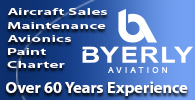The five-blade composite prop recently certified for a variety of Twin Commander turboprop models certainly checks the proper box for ramp appeal, but how about performance?
MT makes some wide-ranging claims about the new MT’s effect on Twin Commander models 690, 690A, 690B, 690C, 690D, 695, 695A, and 695B:
- Reduced take off roll
- Enhanced cruise performance
- Significant cabin noise reduction as well as outside noise reduction
- Nearly vibration free propeller operations
- Cooler engine starts
- Better erosion protection
- Unlimited blade life
- Superior ramp appeal
But do those claims stand up under scrutiny? That was the question Matt Hagans was asking when he was considering offering the new MT props to his Eagle Creek Aviation Services customers. So, when the exclusive distributor of MT’s Commander props, Mike Laver of Air 1st in Aiken, South Carolina, paid a visit to Eagle Creek, Hagans went flying with him to get the answer. Here is his report:
“I had the opportunity to fly the 690B-10 aircraft equipped with the MT five- blade props with Mike Laver, MU-2 guru and U.S. MT distributor. I flew the aircraft myself with Mike in the right seat. The flight consisted of a climb to FL260 (the plane was pressurization-limited) with speed runs, then a descent, some slow flight, and pattern work.
“Honestly, I was not an enthusiastic proponent of these props. I know MT now has long experience with the composite props (wood core) on turboprops, but wood?? I also assumed, from my test-flying days, a shorter-bladed prop would suffer in top speeds.
“Subjectively, the plane was remarkably quiet and smoother. iPhone dB(a) was about 85 on takeoff and dropped to 82 dB in cruise. Many Commanders register 100 on takeoff and above 90 in cruise. 6 dBA is roughly 50% in perceptible noise, so this is really significant. I believe a lot of the perceived noise in the Commander is a result of vibration, and the absolutely smooth nature of these props likely helps the noise. Also, the frequency is higher and thus more pleasant, and when setting the props slightly out of sync the heterodyne was not as noticeable.
“The low frequency ‘chest beat’ between the picture windows is gone. Importantly, the low noise level was fairly even throughout the cabin, even at the rear-facing chairs between the prop arcs. I would characterize the noise level and frequency to be similar to what I perceive in a late-model KA-200/250.
“Takeoff acceleration is improved, but I can’t tell you exactly how much less runway we used; my guess is 10%. The biggest performance difference to me is climb. I can’t continue a 120-knot climb comfortably in a three-blade Dash 10; it just feels uncomfortable to me. (I have +/- 6000 hours in Commanders.) This thing felt really good at 120 knots and the climb was really awesome. It goes straight up. It just felt as if it would keep the high deck angle and 120 knots forever. My guess is 20% better initial climb at lower altitudes and maybe 10-15% better above FL200. We did not do single-engine work.
“I have been suspect as to what cruise speeds would do, having some experience some years ago with shorter four-blade experimental props on the Commander. Mike and I obtained exactly 198 KIAS/300 KTAS at FL260 at -24C with 1900 lbs fuel aboard, four pax, and 100% RPM. Reducing RPM to 97% yielded 194 KIAS—about 292 KTAS—and a truly wonderful level of cabin noise such that I could easily talk to the bench occupants from the cockpit.
“My gut is the plane is the same speed in cruise or even 3-5 knots slower—certainly not the big drop I expected. The contour and critical airfoil nature of these blades must be the reason. Slow flight, NTS, was no change. We could not get an acceptable descent rate as flight idle fuel could not be adjusted down below 210-220 pph on the left engine at 100%. On the four-blade some years back, when we flattened the blade angle to get an acceptable descent, I noted the early onset of tail-stall characteristics from blocking the elevator; these props showed no such tendency.
“In short, I got the same results as Mike reports on the MU-2, but no detectable speed increase. Thus, I see no appreciable range improvement except from reduced time-to-climb and maybe a higher flight level choice.
“I don’t know what these critical blades will do in thinner air, like FL350 on a 900 or a 1000, but MT’s experience on the Cheyenne 400 at FL370 is reported as no loss of cruise (this is not confirmed).
“Based on the incredible noise level (and amplitude and frequency), improved climb, and no significant loss of cruise speed, I am a believer. However, I am now a believer due to ramp appeal, climb, and really terrific improvement in noise and comfort. I signed up as a dealer and bought a set for my 1000 as a demo bird. Feel free to call me if you have other questions.”
The new five-blade, full-feathering MT props, with nickel leading edges, sell for $98,500 a pair exchange, plus freight from Germany and installation. For more information contact Eagle Creek Aviation Services at 800-487-3331 or visit www.eagle-creek.com; call Air 1st at 803-641-9999 or visit www.air1st.com.




